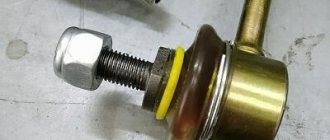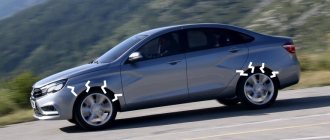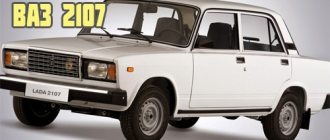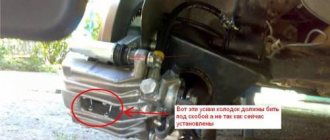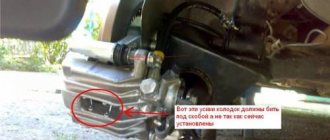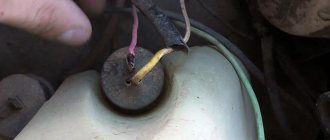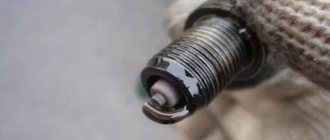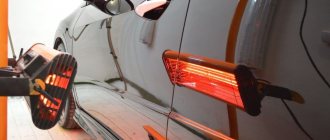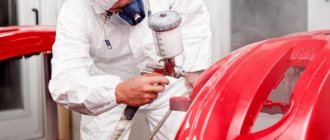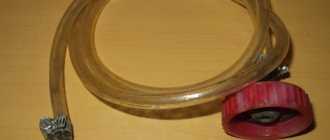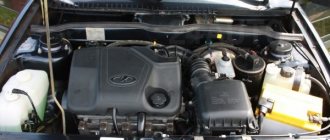Specific hum conditions
This article focuses on the causes of brake buzzing after loads.
It is also worth noting that this article will discuss the possible causes of only one specific type of brake hum. Namely, when it manifests itself exclusively after intense driving. This can be a long drive in city mode, where acceleration and braking alternate one after another. This also includes a hum that occurs after a few moments of pressing the pedal when driving at a respectable speed.
Any other noises - rattling, whistling, grinding, clanking - even if it is possible to “cure” after reading this material, then this should be perceived as random luck. The article is also not about vibration of the brake pedal and beating of the steering wheel. By the way, all of the above is much easier to diagnose than when a hum when the brake is pressed occurs precisely under load. We will try to solve this specific problem further.
Summer and winter car tires: what is the difference
When a set of winter tires is replaced with summer tires, the noise when driving the car becomes louder. All drivers notice this fact. Experienced motorists do not worry about this, but beginners do. To understand why tires hum, you should study a little the features of summer and winter tires.
The key difference is the composition of the rubber compound. Mix production is the first stage in the technological cycle of tire production for use in different seasons of the year. Accordingly, tires for summer and winter are different in their characteristics and tasks. To produce winter tires, a softer mixture is used, taking into account driving on slippery roads and at low air temperatures. Soft rubber ensures reliable adhesion of the “contact patch” of the wheel to the road surface. Accordingly, it is characterized by a low noise level when moving.
Summer tires are made from harder rubber, since the main task is to maintain stability and hardness on the road. When changing a “soft” tire to a “hard” one, drivers notice a hum from the rubber. This is a common occurrence.
In addition, tires for summer and winter differ in tread pattern. In the first option, it is smoother, since the road surface does not have winter “surprises”. In the second case, the tread is more pronounced. The pattern is characterized by a large number of grooves that perform the task of removing snow while driving. The number of sipes has also been increased for better tire grip on slippery surfaces.
All possible causes of hum
As in the case of any other car breakdown, the search is most effective if you have in your arsenal a list of all the most likely causes. When you have such a “cheat sheet” in your hands, all that remains is to methodically work through each of its points, and the solution to the problem will not be long in coming.
It is reasonable to “dig” when the brakes are humming in the following directions:
- Tanning pads.
- Overheating disks.
- “Boiling” brake fluid.
- “Aspen leaf” effect.
- Wear and other disc defects.
- Wedging of guide supports.
- Wheel bearings under load.
If the braking system is a dark forest for you, and the listed items on this list do not mean anything to you, below attention is paid to each of them. Including, in clear words, it is told where it is located, how it affects the buzzing, on what basis to confirm or exclude the diagnosis, and also literally in a nutshell about “treatment of the disease.”
About such assumptions of “experts” as dead “grenades”, some kind of wrong tires, worn out pads and other crap - you won’t find anything here. Such pseudo-reasons have nothing to do with the problem under consideration. They are often mentioned, of course. But this is just to have more text. At the same time, the real possible reasons are not even mentioned.
Crunch in the gearbox.
If your car is equipped with a manual transmission and while driving you hear some kind of crunching noise when changing gears, this may be the first symptom of various problems appearing in the car. As a rule, this is primarily due to the fairly high mileage of the car itself and, secondly, to the natural wear and tear of certain gearbox parts.
To begin with, this crunching sound in the gearbox when changing gears can clearly indicate wear and tear on the synchronizers themselves and other components of the gearbox. Synchronizers, as many of us know, play an important role in any gearbox, equalizing the speed of rotation of the shafts and gears in the transmission to subsequently transmit the required torque at a certain speed.
This crunching noise may also indicate clutch wear. Typically, with this malfunction, this crunching noise appears when the clutch pedal is fully depressed while shifting gears. The same thing usually happens with a working clutch, when you do not fully depress the same clutch pedal.
Tanning pads
This item includes both tanning pads, tanned and life-long oak pads. Let's first consider how they differ. Lifetime oak brake pads are called brake pads that, right out of the box, do not meet the required hardness levels. Experienced car enthusiasts can easily identify them, as they say, by touch, as well as by sound, by lightly hitting a pair against each other. Also, such pads quickly and unevenly chip, chip and cannot brake effectively a priori.
Tanning pads include those that are prone to changing hardness under load. That is, they are not bad in themselves. But as soon as heating occurs as a result of friction against the disk, the material immediately hardens. Cheap fakes usually suffer from this problem, selling for a few dollars a pair. It is clear that for that kind of money they can be made either from baked horse manure, or from sharpened drawing pencils...
Identifying oak pads is not easy, but it is possible
The last option is stiff pads. These can work great out of the box, they don’t buzz, they brake great, and so on. But once you “bake” them a little, by vigorously braking a couple of times between traffic lights or at high speed, they forever become harder than diamond. Doesn't let them in even when they cool down. Unfortunately, such pads can be found both among branded models and original ones.
Whatever the option in your particular case, the sound of the brakes is guaranteed. While the pads are still cold, they can be “silent”. But as soon as you drive through heavy traffic, between traffic lights, or try to stop quickly from a speed above 120 km/h, an impressive rumble begins to be heard. Sometimes it feels like the sound spreads throughout the body, bringing to mind who knows what terrible thoughts.
How do you know if your pads are harder than a coffin nail? As mentioned above, an experienced car enthusiast who holds them in his hands more than once in his life will most likely be able to determine this. If you have no experience, then the chances are zero. Perhaps elementary logic will help - if the pads have recently been changed and a hum has appeared, obviously someone saved on new spare parts.
One way or another, the way out of this situation is the same in both cases. The pads need to be replaced. If you are not sure that they are to blame for the hum, first work through the remaining 6 points of our “cheat sheet”. Perhaps the problem is not hidden here.
A hum in the cabin when the car is moving - what could it be?
Many automakers attach great importance to sound insulation; silence in the car interior has a positive effect on driving comfort. The resulting hum causes discomfort, makes the driver nervous and turns the trip into an ordeal. We have to understand the reasons for its appearance and possible solutions.
1 Faulty wheel bearing - how to determine the failure?
The cause of the hum can be not only the appearance of a malfunction, but also the influence of external factors. These include strong side or head winds, poor-quality road surfaces, for example, if tracked vehicles have passed over them. Winter tires may hum on asphalt. All of the above reasons do not pose a threat to either you or the vehicle. Another category is a hum caused by a malfunction in the car. There are many reasons for such sounds, we will look at the most common ones.
A hum in the cabin when the car is moving is often caused by a faulty wheel bearing. Usually the hum is heard from one side of the car's wheels when accelerating; it can be accompanied by vibration in the floor and will intensify when turning. If you can clearly determine which wheel the noise is coming from, just touch the hub; it will be hot.
To more accurately diagnose the problem, you need to use a jack or lift the car on a lift. Then spin the wheel with a sharp movement; it should rotate freely without making any extraneous noise. If the bearing is broken, a characteristic sound will come from the hub. The presence of play will also indicate a malfunction. To check this, grab the wheel in a vertical plane (top and bottom) and swing it until it breaks. These two procedures must be done with each wheel. The discovery of a defect will indicate the need to replace the wheel bearing; if you are lucky, you can get by with replacing the lubricant; it happens that it dries out.
At the first stages, only a hum will be heard; the appearance of vibration indicates the need for urgent replacement. Do not use the vehicle until it is repaired. A bearing that is jammed or scattered during movement will most likely lead to an accident.
2 Noise from the engine compartment - what are the reasons?
A hum from the engine compartment can be caused by a number of reasons. The simplest of them would be simply loosening one or more belts. Then the hum will increase with engine speed. In this case, it is enough to visually assess the degree of tension and, if necessary, tighten the belt. It should not bend more than one centimeter when you press on it. If after tightening the sound does not go away, the best solution would be to replace this belt.
It is also possible that the bearing of the pump or generator may fail; they will also make a hum. A failed pump bearing will prevent the device from performing its function, and the engine temperature will rise. If you do not make a timely replacement, the hum may develop into an unpleasant knock. If the alternator bearing is faulty, the charge level of the battery will decrease, and on modern cars the warning light will light up.
When engine mounts fail, the noise is accompanied by vibration throughout the body. To determine the malfunction, open the hood; with a sharp change in speed, its instability will be noticeable. Replacing the supports is a very labor-intensive process; its implementation requires lifting the engine with special equipment. It is better to replace it at a service station.
3 Noise when braking – 5 influencing factors
When braking, this sound can indicate a number of possible causes, and is usually accompanied by a noticeable vibration. The process of identifying a malfunction is quite complex; to save the budget, we recommend carrying out diagnostics in a certain sequence, using the method of elimination.
- First of all, check the pads; it happens that they are very worn.
- Evaluate how the calipers are secured.
- Just in case, check the wheel balancing, they also have an effect.
- The presence of air in the brake system can cause similar “symptoms”. Eliminate the cause of the air ingress; if you haven’t changed the brake fluid in a long time, it’s better to do so.
- The last possible cause is unevenly worn brake discs, which will require replacement. This happens due to poor quality pads or not replaced on time.
4 Other reasons – why else do we hear a hum?
A hum coming from the bottom of the car indicates a problem with the gearbox. The most common problem is a failed input shaft bearing. Diagnostics is very simple: when the car is moving, just turn off the gear. If the sound disappears, the bearing is faulty and requires replacement.
On rear-wheel drive vehicles, the rear axle gearbox can create a hum. It intensifies as speed increases. There are two options to solve the problem. In the first one, we simply add oil to the gearbox. If this does not help, the gearbox must be replaced. Drivers of the Soviet automobile industry are well aware of this problem.
If a hum occurs at certain engine speeds, the cause may be a loose exhaust pipe that is leaning against other components of the car.
If the sound appears when you press the clutch pedal, there may be a problem with the release bearing. Replacing it will correct this deficiency. There are many reasons for a hum to appear in a car; the article lists the most common of them. But be sure to remember, each car has its own characteristics, you need to make a decision carefully, carefully analyzing the situation.
Overheating disks
This is what a burnt brake disc looks like
Firstly, overheating discs are extremely ineffective at stopping the car. And all because brakes are a converter of kinetic energy into thermal energy. When there is nowhere to put the excess heat, the transformation slows down and sometimes stops altogether. To be fair, it should be said that critical overheating of disks is not always a failure. All brakes have a certain reserve, which can easily be exhausted during aggressive driving. This is why sports cars have such high demands on these parts - they are made of ceramics and other “nanomaterials”, larger in size, and so on. All for the sake of cooling.
Secondly, overheated disks can and will hum. This is the norm. Deviations from it are only those cases when overheating occurs inappropriately quickly. For example, a couple of traffic lights, and that’s all - hum and floating brakes. If this is the case for you, then there is a reason to check the discs for wear or uneven output. A few words are said about this below.
Growling or vibration when turning the steering wheel.
If your car starts to growl when turning, this may be the first sign of a failing power steering pump. Please remember, friends, that you cannot ignore the signs of a faulty power steering, since this is primarily a matter of your safety while driving the car.
Today, many modern cars and trucks are equipped with electric power steering. Therefore, you need to know and remember that if your car has an electric power steering, then such a growl and therefore a malfunction when turning the car simply cannot exist, it (the growl) cannot appear.
However, today on the roads of our vast homeland there are still many cars that are equipped with hydrolytic power steering. Therefore, every driver of such a car must carefully monitor the power steering and treat this hydraulic system with care, change the fluid in this power steering in a timely manner and diagnose the entire system for hidden defects.
"Boiling" brake fluid
If you ask hundreds of car owners which of them change their brake fluid at least once every two years, what do you think will be the answers? And how often do you change it yourself? Let's be honest with ourselves. Rare is the car enthusiast who has changed the brake fluid at least once in his life. The main thing is the oil. As for the rest, at least the grass won’t grow, as they say...
Useful tool to measure brake fluid temperature
Meanwhile, brake fluid is by no means eternal. It, like motor oil, exhausts its service life and loses the properties inherent in it. Moreover, it doesn’t matter at all what she looks like. Many people think that crystal clear brake fluid that has not changed color or become cloudy is an indicator of its suitability. But that's not true. Like all other working fluids in a car, it must be periodically replaced, followed by bleeding the system to remove air. How often should this be done? Ideally, at least once every two years. Moreover, it is not that expensive. Yes, and there is a little of it there.
Now let's return to our problem - the hum of the brakes. It may very well be that this kind of defect occurs due to a liquid that has lost its properties. It is often said that under load it “boils”, as a result of which it ceases to perform its functions. The hum is also quite reasonably present. Therefore, if you have had the car for more than two years, and you have not changed this consumable, there is no point in moving on to the rest of the items on our list. Replace. Even if it doesn't help, fresh brake fluid won't harm your car anyway.
Squealing (sharp squealing) under the hood.
If your car's engine makes a squealing sound (squealing), it may be due to an old or worn belt tensioner pulley. Usually, when the belt tensioner roller wears out, the belt tension itself weakens, as a result of which the belt simply begins to slip, and this, in turn, will ultimately lead to its breakage.
Fortunately for any motorist, repairing this part is quite simple and inexpensive. But it’s better not to let it get to such a state that the belt in the car simply breaks. Friends, you just need to change all the drive belts in the car and the same alternator belt on time.
If you do not bother to change all these components of the car in time, then one day, finding yourself on an empty road somewhere at 2 a.m. and even in winter when any belt in the car breaks, you will immediately quickly understand how important it is to carry out regular maintenance of your car. vehicle, how important it is to promptly change faulty car parts.
“Aspen leaf” effect
This lyrical definition is what car enthusiasts call the effect when a brake disc, being squeezed between the pads, begins to tremble like an aspen leaf in the wind. Often this defect is accompanied by a hum. It does not always appear, but just after a good load to which the brakes are subjected in city driving. Unfortunately, the “aspen leaf” cannot be seen. Moreover, it does not always manifest itself in the form of standard vibration on the pedal.
There are several methods that allow you to identify the “aspen leaf” indirectly
However, you can understand that this effect is present on your car indirectly. For example, if the discs are worn beyond normal limits. You can check this using a caliper. You need to measure the thickness of the disks. Here you need to know that they can be ventilated or unventilated. The first ones differ from the second ones by the presence of ventilation holes, which are visible if you look at the disk from the end. The normal thickness for the former is 18 mm, and for the latter - 10 mm. If you have noticeably less, the “aspen leaf” effect is guaranteed. And along with it comes the hum of the brakes when you press the pedal.
What to do with such a diagnosis is probably obvious. Worn discs can only be replaced with new or used ones, but in good condition. By the way, sometimes the second option is preferable. Especially if you need it cheaper. Buying new and the cheapest is a bad decision for any car part.
Engine rattling or knocking.
If your engine makes a rumbling or thumping-like noise that gets louder as the speed increases, then this may mean that you have a serious problem with your vehicle's powertrain.
If you hear a “knock-knock-knock” sound or similar sound, then perhaps the oil pump in the car does not supply oil with the required pressure or the same engine valves require adjustment of the clearances. A knocking sound in the engine itself may not necessarily mean a serious problem with it, but any extraneous sound in the engine requires qualified diagnosis by a specialist. The sooner you do this, the better it will be for you.
If this knocking sound is located and heard from somewhere deep in the engine, then it is likely that you are (will) have an expensive engine repair. For example, such a knock in the engine may indicate a malfunction of, say, connecting rod bearings, etc., which will cost you a considerable amount of money to replace.
In this case, friends, try not to delay diagnostics and the repair itself, since worn connecting rod bearings can seriously damage the engine itself, which will certainly lead you to more expensive repairs.
Wear and other disc defects
There are several types of wear on brake discs that can cause a hum to be heard under the described conditions. The first of them is the so-called furrows. They are clearly visible to the naked eye, sometimes even directly through the rims. They appear there for all sorts of reasons. The most obvious is any abrasive getting between the pads and rotating discs. Coarse dust, sand, dirt, small pebbles. All this can “register” water circles on disks.
In this condition, the brakes not only hum, they are also ineffective.
The second type of excavation is a protruding edge. This defect usually leads to a hum when you press the brakes when the pads are changed. Very often these parts are purchased the wrong size, which, however, does not interfere with their successful installation. As a result, the pads do not contact the discs correctly and can overheat, wear unevenly and bite each other. Which of these causes the buzzing doesn't really matter.
The next defect is corrosion. It is observed in the form of small pits directly on the working surface of the disks. At a certain degree of severity, it can also cause brake noise. Again, the root cause is overheating under load. Parts overheat, a hum occurs, and braking performance may deteriorate.
The next possible problem with discs is when they are burnt or set on fire. These can be identified by blue or iridescent spots directly on the work surface. They say such “burns” mean that the brakes have been overloaded once or repeatedly. As a result, you should look for inadequate wear or deformation. In any case, this may well be the reason why the brakes are buzzing.
In all of these situations, the “treatment of the disease” is the same. This is a replacement brake discs. It should also be understood that after working together with defective discs, the pads are also very likely to become unusable. There is no point in using them with new disks. It is better to immediately replace with new ones. Fortunately, even if they are of high quality, these consumables do not cost a fortune.
It’s probably worth saying a few words about turning discs, which many car enthusiasts resort to. This repair method is justified, unfortunately, only in 1 case out of 10. And even then, if the groove was entrusted to a competent turner, and they did not try to “align” the disc with a grinder directly on the machine. The latter is strictly not recommended. The brake system is a mechanism that does not forgive inaccuracies. And the grinder and accuracy are antonyms.
Ways to get rid of noise
There are several effective techniques that will help you forget about wheel noise at least for a while:
- First of all, it is worth checking the tire pressure, because both its excess and its deficiency provoke the appearance of unpleasant sounds. In addition, non-compliance with the standard for this indicator leads to intense wear, which is also unacceptable.
- If the pressure does not go beyond the permissible limits, then it is worth balancing the wheels, and also checking the angle of their installation on the front axle on a stand.
- It also wouldn’t hurt to analyze under what conditions the wheels make the most noise, because it is possible that the real culprit is the quality of the road surface in certain areas.
Some craftsmen have come up with their own method of sound insulation, applying a thick layer of anti-gravel to the wheel arches:
- To do this, it is necessary to disconnect the element, thoroughly rinse and dry it, and then partially cover it with vibroplast so that in the end its area occupies about 60% of the entire surface of the element.
- The next stage involves applying anti-gravel in 5 layers to areas free of vibroplast.
- The bottom is treated in a similar way, which not only makes the car less noisy, but also protects it from corrosive changes.
Wedging the guide supports
All the main elements of the car's brake mechanism are shown here,
including guides
This problem occurs in several different stages of difficulty. Some people's calipers jam so much that the brakes continue to work quite intensely even when they are not required to do so. For others, the pads, although effortlessly, are still in constant contact with the discs. It is clear that all this leads to chronic heating of the brake system parts, and a hum will be heard when pressing the pedal under normal load.
In most cases, jamming of guide supports can be easily “treated” with your own hands. To do this you need:
- Make sure the anthers are intact.
- Carefully inspect the guides for clogging or corrosion.
- If the last two are present, clean them.
- Lubricate the guides.
As a matter of fact, due to the not entirely comfortable conditions in which these parts of the brake system are constantly located, jamming is a common cause of buzzing. The anthers collapse, crack, and slide off. The lubricant is washed out with water. Dust and dirt accumulate on the “mirror” of the guides. Next comes corrosion and the corresponding consequences. Therefore, if the repair is successful in this direction, do not forget to periodically check the guides for the integrity of the anthers and the presence of lubricant. After all, problems can be even worse than some kind of brake noise.
Attention! Very often, when manipulating the brakes, car enthusiasts use the well-known WD-40 or analogues. Yes, it helps a lot in developing soured parts. But it also “loves” to get on the brake discs, which subsequently completely deprives the car of brakes for some time.
Crackling or crunching.
If your car is front-wheel drive and at low speed you hear some crunching or crackling (especially when you turn the steering wheel all the way when turning), then the probable cause of this crunching or crackling noise in the car is a faulty CV joint.
These rather complex parts of the car transmit torque from the gearbox directly to the wheels. If friends do not change the CV joint in the car in time, then the drive of the car can severely break the mounting sockets in the gearbox, and this is fraught. Therefore, dear motorists, remember, if you hear a crunching or crackling sound in the front suspension of your car, immediately contact a car repair shop to diagnose and eliminate this malfunction.
Also remember, periodically inspect the CV joint boots themselves to identify cracks and damage in the boots. The CV boot protects the drive from dust and sand getting into it, which can severely damage the CV joint.
Wheel bearings under load
The humming sound when you press the brake pedal may not be related to the brake system.
It’s probably worth starting with how armchair experts refute this reason. Such experts say that wheel bearings cannot make a hum exclusively when you press the brake pedal. That is, if a scribe came to them, then they make noise even during a simple drive. In fact, this is, to put it mildly, a misconception.
Wheel bearings can only hum under load. This happens to them when they are just beginning to deteriorate. That is, in normal driving mode they are “silent”, and even the swaying of the wheels on the jack from side to side shows that everything is fine with them. But the loads for wheel bearings are two modes:
- Turns.
- Braking.
With turns, it should be clear without explanation - under the influence of centrifugal force, the mass of the car shifts, unloading one side of the suspension and loading the opposite. But absolutely the same problem occurs with braking. When a car brakes, its weight shifts sharply along the motion vector. As a result, the front wheel bearings experience increased loads. The result is a hum, the cause of which we are trying to find here.
Actually, if the search for the problem points to this point, then, in principle, there is no need to rush to replace the “weak link”. Let us remind you that here we are considering only the kind of brake noise that appears exclusively after a good load. Accordingly, if the wheel bearings are to blame, then with a high degree of probability they will still work, as they say.
By identifying the source of noise in your car yourself, you can save a lot of money.
Nowadays, we all know that due to the increased cost of almost everything, all repairs and maintenance of even an inexpensive car take a heavy toll on the family budget. Naturally, every car owner is not averse to saving on the costs associated with maintaining a car. As a result, today more than ever it is very important to learn how to independently diagnose problems that arise in your car. This can help you save a significant amount in the future. After all, if a fault in a car is not noticed in time, over time the breakdown may become more significant.
Here are some recommendations on how you can independently identify the source of noise in the car, which will allow you to look for the cause of the malfunction in the right direction, and not guess on the coffee grounds, as they now like to do in car repair shops, shaking various components one by one. Here are the main sources of noise in a car:
- Noise when the vehicle speed increases is a possible problem with the wheels.
- Noise from under the hood after increasing engine speed is a possible problem with the engine.
- Random noises that are not related to engine speed or vehicle speed are likely suspension problems or road noise.
Noise and hum when the car is moving
Noise and hum when the car is moving
Every driver and passenger dreams of a quiet, comfortable car to enjoy soft music or conversation during the trip. The noise level in the cabin is a kind of indicator of the level of comfort of the car.
In reality we have a different picture. A car, which is a collection of many components and parts, no matter what brand and model it is, creates noise, hum and vibration while driving.
Natural causes of noise
All noises and hums created when a car is moving can be divided into natural noises and noises associated with a car malfunction.
Natural noise is created by the tire tread when driving on asphalt, concrete or any other surface. The higher the vehicle speed, the more noise from the wheels penetrates the vehicle. When driving on poor-quality surfaces, the noise from the wheels turns into a real hum and creates some discomfort when traveling, especially over long distances. Car tire manufacturers try to reduce the noise from rolling rubber as much as possible, but it is not possible to reduce it to zero.
Natural noise is also aerodynamic noise arising from the car body. The drag coefficient is the focus of attention of all car designers and constructors, and in most modern cars it has good indicators. But with a strong headwind or crosswind, aerodynamic noise can occur in the area of protruding parts of the car body (rear view mirrors, antenna, roof rack). The characteristic noise of a running engine and exhaust system is also normal, unless of course it exceeds the permissible level.
Noise due to vehicle malfunction
Another category of noise and hum is associated with malfunction of vehicle components and parts. Faulty wheel bearings, for example, create a peculiar hum that stands out above other noises, which intensifies when the wheel is loaded.
The bearings of the water pump and generator in the engine compartment can also howl. When the bearing completely collapses, the hum turns into a crunch. A malfunction of the car's suspension (silent blocks, vertical stabilizer bars, levers, brake pads, calipers, etc.) is characterized by a metallic knock when driving on an uneven road. A malfunction of the vehicle's transmission (gearbox, cardan drive, constant velocity joints) is also characterized by a peculiar characteristic hum and howl. Vehicle vibration occurs when engine mounts fail or tires fail (wheel runout). Less often, mainly when driving over rough terrain, noise occurs from objects accidentally stuck in various parts of the car. This could be a pebble caught between the brake disc and the wheel disc, a wire wrapped around a wheel or caught on the bottom of the car, or other objects.
Is it necessary to carry out complete sound insulation?
Every car owner must distinguish natural noises from noises associated with a vehicle malfunction. Natural noise can be reduced by using a car interior noise reduction procedure. However, it should be understood that the driver must, with a low volume of the radio (radio) or a quiet conversation inside the car, clearly and distinctly hear the sound signals of other cars, as well as the sirens of special cars, in order to respond to the traffic situation in a timely manner.
The erroneous opinion of some drivers who want to turn the car interior into a kind of deaf aquarium. Thus, they deprive themselves of such a human organ of touch as hearing. Sound insulation of a car should also ensure the driver’s safety; it is also necessary to promptly hear and identify noises associated with a car malfunction. Moreover, many of them require immediate contact with service to troubleshoot problems.
Noises from foreign objects can be identified and eliminated after a visual inspection of the vehicle. Other noises associated with vehicle malfunctions can only be detected at specialized service stations.
Knocking and creaking in the steering
Knocking and creaking when turning the steering wheel can come from the gearbox, where the main (worm-roller) pair has worn out. Most often, to correct this problem, it is enough to adjust and lubricate the steering shaft.
The knocking of steering rods and ends is more reminiscent of the knocking of ball joints and also appears only when driving on bad, uneven roads. In case of such a malfunction, it is recommended to urgently change the tie rods with tips.
Ball joints knock or squeak
The knocking or creaking of ball joints can be clearly heard when driving on a bad road with uneven surfaces. Usually the problem begins with a squeak, and if the problem is not corrected for a long time, it comes to knocking, which indicates critical wear of the support.
It should be remembered that ball joints are nothing to joke about, and the matter can end in a serious accident or an emergency stop in the middle of the road with a half-fallen wheel.
Knocking and creaking of shock absorbers and springs
Shock absorbers
The knocking and creaking of the shock absorbers can be clearly heard when driving on a bumpy road. Probable causes: rubber bushings and cushions are worn out, oil has leaked from the shock absorber.
Operating a car with such malfunctions is dangerous, since the stopping distance during emergency braking almost doubles.
It is also not difficult to determine an oil leak from a shock absorber; usually traces of leaked oil (with adhering dirt) are clearly visible on the shock absorber body. Of course, a leaking shock absorber must be replaced.
Springs
A metallic grinding sound often comes from springs, which indicates that they are incorrectly installed or broken. The place where the grinding noise comes from can be determined by shaking the body, and a broken spring can be identified by a sagging wheel arch or by visual inspection.
Abnormal sounds in the engine compartment
Squealing sound after starting the engine
A piercingly unpleasant squeal can appear not only after starting the engine, but also with a sharp increase in speed, which indicates a problem with the alternator belt. Most often, to eliminate unwanted sound, it is enough to tighten the alternator belt. If after a while the squealing appears again, you need to replace the alternator belt.
Whistle or rumble at idle speed
The indicated sounds in the engine compartment, in the front part, indicate a malfunction of the pump, which must be replaced.
Acceleration of the car is accompanied by a metallic ringing knock.
The reason for such a knock may be:
- detonation due to incorrectly set (early) ignition timing;
- detonation when the engine overheats;
- use of faulty spark plugs;
- use of low-quality fuel;
- excessive carbon deposits in the combustion chamber;
- engine overheating.
The ringing metallic knock in the engine is created by the pistons, which take on the shock load after the explosion of the combustible mixture in the combustion chamber. Continued operation of the machine with such a knocking noise can lead to serious damage to the engine, so the cause of the malfunction must be eliminated as soon as possible.
Roar, pops and “shots” from the muffler
These annoying sounds are familiar not only to drivers, but also to ordinary people. A characteristic roar during engine operation, which increases as the vehicle accelerates, clearly indicates problems with the muffler. This is usually due to a violation of its tightness (a hole from an impact or in rusted places).
If the muffler is slightly corroded, it can be soldered, and if this is not possible, it must be replaced.
